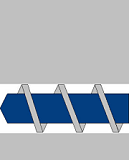The Competence Centre for Wood Extrusion established by Cincinnati Extrusion, Vienna in co-operation with Cincinnati’s partners Fasalex, JRS, TechWood and PPT as a forum for all questions concerning wood processing, enjoyed unrivalled popularity at the K 2001 exhibition. Even the participating companies were surprised by the overwhelming feedback. Due to the successful presentation at the exhibition, wood extrusion experienced a breakthrough with plans for large-scale production of fibre profiles, and as a result first orders have been placed. The Dutch company TechWood International, participating in the SMS Technology’s joint exhibition stand, finalised a large-scale order during the exhibition. Over the next five years, Industrias Vassallo Inc. of Puerto Rico, the largest plastics processor in the Caribbean, will be producing wood profiles for 50,000 hurricane-proof houses. Vasallo has acquired a licence for the production of wood profiles from the Dutch company TechWood. Moreover, both business partners agreed that TechWood will produce the initial 1,000 houses at its own production site in the Netherlands pending completion and start-up of the new Vassallo facility in Puerto Rico. TechWood, Vassallo’s license and business partner, works with renowned machine suppliers. The company uses extruders of Cincinnati’s Titan F series for its extrusion processes. These extruders are already successfully operating at TechWood’s Dutch headquarters. Conical twin-screw extruders of the Titan F series are perfectly suitable for processing materials with low apparent density which are characteristically used in wood processing. These extruders’ feed throats have specifically-designed wide openings to accommodate bulky material. They offer the additional advantage of providing a wide diameter in the screw’s feed section combined with continuous compression brought about by the conical shape. Metering zones with a low volume and small surface area reduce the friction to a minimum and thus guarantee high-quality products. Moreover, the short residence time in the Titan F extruder ensures the protection of thermally unstable natural materials. In conical extruders, residence time is halved in comparison with parallel extruders.
